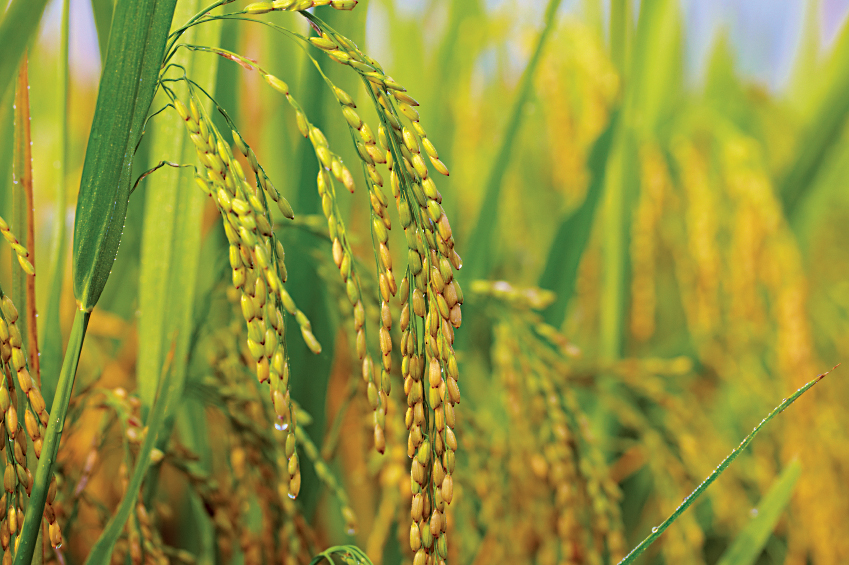Home > Mississippi > Mississippi Crops & Livestock > Rice: A Staple for Mississippi’s Economy
Rice: A Staple for Mississippi’s Economy
In partnership with: Mississippi Department of Agriculture and Commerce
 Multitudes worldwide rely on rice as a staple food source. The crop is equally vital to Mississippi, accounting for more than $100 million annually in production value. One of six rice-producing states, Mississippi’s 2012 rice crop survived Hurricane Isaac’s fury and was spared from the season’s drought. The year produced a near-record yield of 160 bushels per acre. But fewer planted acres dropped the state rank as the country’s fourth largest rice producer to fifth. “We were down to around 130,000 acres,” says Nathan Buehring, rice specialist at the Mississippi State University Extension Service. “Historically, we average 250,000 acres.” Because market prices have favored corn and soybeans, farmers dedicated fewer acres to rice production in 2011 and 2012, putting Mississippi production behind Arkansas, California, Louisiana and Missouri. Still, Mississippi’s 2012 crop yielded 18.7 million bushels with prices ranging between $6.25 and $6.50 per bushel. Global influences are a major factor in the crop’s future. About half of Mississippi’s rice crop is exported to Mexico, Guatemala and other Central and South American countries. “We’ve had a problem with other people slipping in and taking our market share,” says Mike Wagner, Tallahatchie County rice farmer and former president of the Mississippi Rice Council. “We hope to regain our share this year.” Wagner would like to see the United States open rice exports to Cuba. “We’re the closest market to Cuba, with the exception of Carolina Gold, and we’re the most eastern producer in the United States,” he says. Most of Mississippi’s 341 rice farms are located in the northwest part of the state. Top producing counties are Bolivar, Coahoma, Humphreys, Leflore, Quitman, Sharkey, Sunflower, Tallahatchie, Tunica and Washington. Nearly 100 percent of the farms grow the widely popular long-grain rice. “The soils are conducive to rice production and we have access to water that gives us the capacity to grow rice,” Buehring says. Rice is planted in the Delta beginning in April and continuing through mid-May. A dry seeded method is used with field flooding taking place after seedlings set. Harvest occurs late August through October. Farmers use a combine to cut stalks and strip rice grain from the plant. After the harvest, farmers become conservationists. They flood the rice fields in late fall to help break down any remaining plants. The flooded, shallow fields provide food and wintering grounds for waterfowl and shorebirds following the Mississippi Flyway. In return, the wetland-dependent birds crush the rice straw, furthering its decomposition and helping prepare the fields for the next season’s planting.
Multitudes worldwide rely on rice as a staple food source. The crop is equally vital to Mississippi, accounting for more than $100 million annually in production value. One of six rice-producing states, Mississippi’s 2012 rice crop survived Hurricane Isaac’s fury and was spared from the season’s drought. The year produced a near-record yield of 160 bushels per acre. But fewer planted acres dropped the state rank as the country’s fourth largest rice producer to fifth. “We were down to around 130,000 acres,” says Nathan Buehring, rice specialist at the Mississippi State University Extension Service. “Historically, we average 250,000 acres.” Because market prices have favored corn and soybeans, farmers dedicated fewer acres to rice production in 2011 and 2012, putting Mississippi production behind Arkansas, California, Louisiana and Missouri. Still, Mississippi’s 2012 crop yielded 18.7 million bushels with prices ranging between $6.25 and $6.50 per bushel. Global influences are a major factor in the crop’s future. About half of Mississippi’s rice crop is exported to Mexico, Guatemala and other Central and South American countries. “We’ve had a problem with other people slipping in and taking our market share,” says Mike Wagner, Tallahatchie County rice farmer and former president of the Mississippi Rice Council. “We hope to regain our share this year.” Wagner would like to see the United States open rice exports to Cuba. “We’re the closest market to Cuba, with the exception of Carolina Gold, and we’re the most eastern producer in the United States,” he says. Most of Mississippi’s 341 rice farms are located in the northwest part of the state. Top producing counties are Bolivar, Coahoma, Humphreys, Leflore, Quitman, Sharkey, Sunflower, Tallahatchie, Tunica and Washington. Nearly 100 percent of the farms grow the widely popular long-grain rice. “The soils are conducive to rice production and we have access to water that gives us the capacity to grow rice,” Buehring says. Rice is planted in the Delta beginning in April and continuing through mid-May. A dry seeded method is used with field flooding taking place after seedlings set. Harvest occurs late August through October. Farmers use a combine to cut stalks and strip rice grain from the plant. After the harvest, farmers become conservationists. They flood the rice fields in late fall to help break down any remaining plants. The flooded, shallow fields provide food and wintering grounds for waterfowl and shorebirds following the Mississippi Flyway. In return, the wetland-dependent birds crush the rice straw, furthering its decomposition and helping prepare the fields for the next season’s planting.



